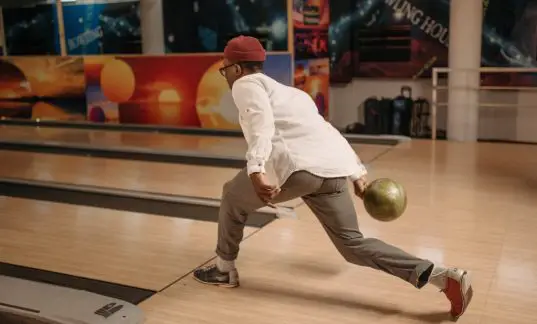No bowler wants to deal with the headache of a cracked bowling ball. New bowling balls are getting more and more expensive, and the thought of investing in a replacement for a cracked ball is a real headache to the budget-conscious bowlers among us.
We’re here to take a look at the hows and why of cracked bowling balls. We’ll show you what causes bowling ball cracks, how to prevent them, and how to fix a bowling ball crack when it threatens to ruin your day!
What makes a bowling ball crack?
Whether it’s a new bowling ball or one that’s been worn down over time, bowling balls can crack due to a variety of issues and calamities. Your bowling ball’s surface is always vulnerable to such hazards as uneven lane conditions and bad air quality. However, some very specific problems can lead to a bowling ball cracking. They are as follows:
High temperatures and extreme temperature changes
Extreme heat and cold are bad news for your bowling ball. Extreme temperatures will weaken the constitution of your ball’s coverstock, potentially leading to a cracked ball. Too much heat will soften the complex elements that keep your coverstock together. Too much cold will weaken the impact and durability of your whole ball. When storing your bowling ball in hot or cold weather areas, search for a controlled environment with limited humidity and a constant temperature in an average range.
Placing drill holes too close to the pin
You must install your bowling ball’s pin in a stable spot that doesn’t put your entire ball’s health in jeopardy. Try to install the pin with a distance of one inch or more from any of your ball’s drill or finger holes. Or, you can install it in a hole itself. If not, small cracks might begin to form when using your ball at your local bowling center. As you can see, even a new ball you just bought from a nearby pro shop is not immune from cracking.
Too much humidity in your storage area or local bowling alley
In short, bowling balls sitting in high-humidity areas are reportedly more prone to cracks and fissures. Whether it’s being stored at your house or on the rack at your favorite bowling alley, things get wonky when temperatures change and humidity increases. Different materials respond to humidity differently, though, so speak with a local pro shop employee or pay attention to your manufacturer’s recommendations when storing your ball.
Gravity
Your bowling ball’s core is often the main culprit that causes a ball to crack. Whether you love Storm balls, Brunswick beauties, or other balls from other companies, new balls, and used balls are delicate things made with a delicate sense of balance. When you store a ball in one space and don’t move it, this balance can be disrupted by the weight of the core pushing down on the coverstock. Balls crack more due to a lack of usage and static storage than anything else.
Manufacturing errors for your bowling ball core or coverstock
Whether you prefer Storm bowling products or offerings from other companies, things sometimes just go wrong. Your coverstock might be too slight, your core might be misplaced, or your thumb hole might have a small crack emanating from it. You may even have custom finger inserts that end up causing issues in the freshly-drilled holes of your ball. Pay special attention to the manufacturer’s warranty of your particular bowling ball if your ball cracks within the warranty window.
Lack of rotation
While this hasn’t been fully proven or fleshed out, there is a generally-accepted truth among some bowlers that failing to rotate your entire ball once a week will lead to cracking. This is more about gravity than actual rotation. Just make sure to move your ball once or twice a week, inspecting the holes for your fingers and the coverstock for potential trouble spots as well.
How do you avoid cracked bowling balls?
While there’s no catch-all solution that will ensure the 100% health of your bowling ball and its coverstock, there are precautions you can take to avoid the perils of a cracked bowling ball.
More hook? More maintenance.
One ball with a polyurethane coverstock and another ball with a reactive resin coverstock have different maintenance needs. Polyurethane coverstocks are less complex and porous and thus require less regular maintenance. High-performance bowling balls crack more often due to softer coverstocks made to absorb oil and promote hooking. Pay attention to the maintenance needs of your particular type of bowling ball and create a regular touch-up schedule to keep it in playing shape.
The joys of a well-made plastic bag
Find a quality plastic bag that’s big enough for your bowling ball to comfortably sit within. Wrap it around the ball with as little air as possible between the bag and coverstock. Use a twist tie to secure the bag around it and store the ball in a low-humidity, temperate environment. This protects your ball’s delicate coverstock from the elements and potential impetuses for cracking.
Play more and move it around
When you bowl with your ball more often, you keep it moving and stop gravity from stressing out its overall construction. Head over to the local bowling center when you can and throw your ball down the lane for a few games or so. Get it warmed up and play with as intended. That’s one of the best ways to keep a bowling ball from cracking.
Do bowling ball cracks mean that the ball is useless?
Nope! A small crack on a bowling ball is not the end of the world. In fact, a large bowling ball crack doesn’t mean that your ball needs to be shelved or recycled for good. Whether you use a bowling ball repair kit to patch it up or use one of the DIY repair methods we’ll profile below, there are ways to salvage your cracked bowling ball and get it back into playing shape.
Also, be sure to keep your manufacturer’s warranty handy. If your bowling ball is cracked to an unusable degree, you might be able to return the ball to the manufacturer for a suitable replacement.
And if all else fails, there are plenty of cool art projects that call for the help of an old bowling ball. Recycling your bowling ball doesn’t just mean sending it off to the thrift store and forgetting about it. An old ball can find new life as a lawn ornament, coffee table centerpiece, or glitter-covered art installation in your son or daughter’s room.
How do you fix a cracked bowling ball?
Do-it-yourself techniques for fixing a cracked bowling ball are not foolproof. They require a steady hand, some useful supplies, and a little bit of luck to work out. However, taking a chance on fixing your bowling ball is a lot cheaper and more satisfying than shelling out a few hundred dollars for a new ball.
Here are the supplies you’ll need to take a crack at fixing a cracked ball:
- Two Reinforced Epoxies (we recommend Gorilla Glue and J-B Weld Kwikweld)
- Masking Tape (such as Scotch General Use)
- Bowling Ball Cleaner (such as Storm Bowling Products’ Reacta Shine Cleaner)
- A Bowling Ball Cup (such as bowlingball.com’s Hammer Ball Cup)
- Abralon Bowling Pads (such as bowlingball.com’s Bowling Ball Resurfacing Kit)
- A Toothpick
- Tissue Paper
- Rubbing Alcohol
- A Toothbrush
- Rubber Gloves
- A Microfiber Towel
Now that you have your supplies in order, here’s a step-by-step breakdown on how to fix a cracked bowling ball:
- Use some bowling ball cleaner to clean the area around the crack. If there is debris in the crack itself, you can use a toothpick or some tissue paper to gently fish it out. Once that’s done, use an old toothbrush to remove dust and dirt from the crack itself.
- Dab a tissue paper or microfiber towel with rubbing alcohol to remove excess grease and oil from the area around the bowling ball crack.
- Cover the immediate area around your bowling ball’s crack with masking tape. Be careful not to cover the actual surface area of the crack.
- Make a 50/50 glue compound of the two epoxies listed above. Mix it nicely and apply it to the crack within four minutes to keep it from drying up.
- Fill the crack of the bowling ball with the glue, using a gloved finger to remove excess glue. Try to fill the crack as much as possible without major overflow.
- Place your bowling ball on the cup to dry for 24 hours in a temperate area.
- Peel the tape off and double-check the status of the crack. Is it smoothed over? Do you need to refill it and try again? Repeat steps 1-7 if the crack is not sufficiently filled. Otherwise, go to our last step…
- Use a set of Abralon bowling pads to smooth out the surface of your bowling ball. Then, use some rubbing alcohol to polish it up nicely! It may not work just like new, but it will be dang close!
Final Thoughts
Fixing a cracked bowling ball is easier than you might think! Don’t give up hope when your favorite ball gets gouged or chipped. Take the steps above to repair it and you might get a few more years of play out of your trusty strike or spare option!

